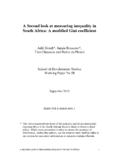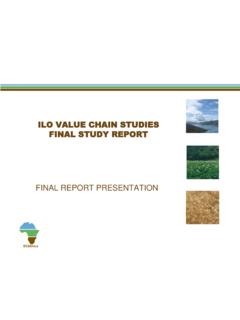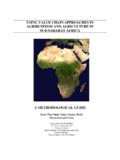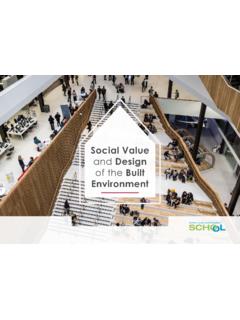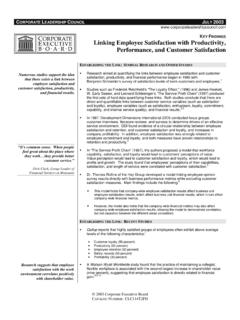Transcription of A Preliminary Study on the Bovine Leather Value Chain in ...
1 INTERNATIONAL COMPETITIVENESS AND Value CHAINS IN SELECTEDMANUFACTURING SECTORS STUDYA Preliminary Study on the BovineLeather Value Chain in South AfricaRichard BallardCSDS Research Report No. 40 May 2001 Industrial Restructuring ProjectSchool of Development StudiesUniversity of Natal, DurbanAcknowledgementsThe European Union through its Department of Trade and Industry Policy Support Programmeprovided the principal funding for the writing of this research report. The financial support receivedfrom the European Union is sincerely appreciated and hereby report would not have been possible without the enthusiastic contributions of a number of firmsand industry role-players who willingly gave up their valuable time in order to supply data and ideasfor this report. In particular I would like to thank Der Anne Dods, Tony Mossop and Ralph Powellsfor their advice and support. Finally, thanks to my colleagues at the Industrial Restructuring Projectfor their invaluable input and assistance on this NO: 1-86840-433-1 School of Development StudiesUniversity of NatalDurban, 4041 Tel: (031) 260 1031 Fax: (031) 260 2359 Email: BallardForewordThe Industrial Restructuring Project (IRP) was initiated at the beginning of 1996 as the KwaZulu-Natal Industrial Restructuring Project (KZN IRP).
2 The project initially focused exclusively onKwaZulu-Natal, but is now aimed at supporting industrial policy in South Africa at the national,provincial and local levels. It is facilitated by international experts and is based at the School ofDevelopment Studies, University of Natal Durban. The project has two important features. Firstly, itfocuses on critical issues that are impacting on the competitiveness of manufacturing sectors that areunder threat from increased international competition and the liberalisation of the South African traderegime. Secondly, it is action-oriented in design. The findings that have been generated have, forexample, been presented to numerous industry stakeholders, including government, businessassociations and trade unions. The project consequently has the support of various regional andnational particular report/working paper has arisen out of both new research and the cumulativeknowledge that has been generated from previous studies.
3 These cover a number of IRP reports,working papers, journal articles and conference papers. Some of the themes covered include SouthAfrica s manufacturing competitiveness, the automotive industry, the clothing and textiles sectors,footwear, middle-management capacity, human resource development, institutional support forindustrial restructuring, and business services for manufacturing competitiveness. Enquiriesregarding IRP material should be addressed to: The Librarian, Centre for Social and DevelopmentStudies, University of Natal, Durban, 4041. Tel: 031 2601031; Fax: 031 2602359; This report can be downloaded for free at (click onpublications).Prof. Mike MorrisHead: IRPC ontents1 INTRODUCTION: OVERVIEW OF THE Leather Globalisation and the new economic operating Value chains in South Structure92 SKINS, HIDES AND of the Value Chain stages of tanneries in South of key issues213 AUTOMOTIVE Motor Industry Development Programme & automotive seat of the of key issues284 GENERAL Leather sector under profile of general goods from imported finished material of key sector under of key issues496 SUMMARY AND POLICY research topics on the Leather industry in options for consideration527 REFERENCES & breakdown for ch.
4 41 - skins, hides & breakdown for ch. 42 general Leather breakdown for ch 64 on imported hides, Leather , Leather goods and questionnaire for Leather products questionnaire for tanneries79R. BallardList of figuresFigure 1: Summary of number of employees registered with the National Bargaining Council3 Figure 2: Summary of exports from various parts of the Leather industry4 Figure 3: The Bovine Leather Value Chain - 20008 Figure 4: Regional change in employment in tanning16 Figure 5: Imports of items listed under Chapter 41: raw & semi-processed skins and hides and finished leather19 Figure 6: Exports of items listed under Chapter 41: raw & semi-processed skins and hides and finished leather20 Figure 7: Value of exports of Stitched Leather Automotive Components26 Figure 8: Unit price of exports of Stitched Leather Automotive Components27 Figure 9: Regional change in employment in general goods manufacture30 Figure 10: Imports of items listed under Chapter 42: general Leather goods35 Figure 11: Exports of items listed under Chapter 42: general Leather goods38 Figure 12.
5 Formal employment in the footwear sector 1918-1999 (SAFLIA 1999)42 Figure 13: Pairs produced from 1918-1999 (SAFLIA 1999)43 Figure 14: Changing employment per region over time (SAFLIA 1999)43 Figure 15: Changing production per region over time (SAFLIA 1999)44 Figure 16: Imports of items listed under Chapter 64: footwear45 Figure 17: Top ten countries exporting shoes to South Africa (SAFLIA 1999)45 Figure 18: Exports of items listed under Chapter 64: footwear48 Figure 19: Dollar Value of imports of un-tanned hides and skins56 Figure 20: Dollar Value of imported tanned Leather (including semi-processed)56 Figure 21: Quantity in kilograms of un-tanned hides and skins imported57 Figure 22: Quantity in kilograms of tanned hides and skins imported (including semi-processed)57 Figure 23: Dollar price per kilogram of imports of skins hides & leather58 Figure 24: Rand price per kilogram of imports of skins hides & leather58 Figure 25: Dollar Value of exports of un-tanned hides and skins59 Figure 26: Dollar Value of tanned Leather (including semi-processed)59 Figure 27: Quantity in kilograms of un-tanned hides and skins exported60 Figure 28: Quantity in kilograms of tanned hides and skins exported (including semi-processed)60 Figure 29: Dollar price per kilogram of exports of untanned skins and hides61 Figure 30: Dollar price per kilogram of exports of tanned skins and hides (including semi-processed)61 Figure 31: Dollar Value of imports of general goods62 Figure 32: Quantity per item of general goods imports63 Figure 33: Dollar price per item of general goods imports63 Figure 34: Dollar Value of exports of general goods64 Figure 35: Quantity of items of general goods exports64 Figure 36: Dollar price per item of general goods exports65 Figure 37: Dollar Value of imports of footwear66 Figure 38: Quantity in pairs of footwear imports67 Figure 39.
6 Dollar price per pair of footwear imports67 Figure 40: Dollar Value of exports of footwear68 Figure 41: Quantity in pairs of footwear exports68 Figure 42: Dollar price per pair of footwear exports69 List of tablesTable 1: Employers and employees in tanning sector16 Table 2: Types of Leather manufactured17 Table 3: Stage of processing at tannery17 Table 4: Types of products in which Leather is ultimately used18 Table 5: Turnover category of tanneries surveyed for the year 200018 Table 6: Ownership status of tanneries18 Table 7: Net exports of types of skins, hides and leathers (2000)21 Table 8: Comparison of prices of imported and exported skins hides and leather21 Table 9: Quantity of auto-upholstery exports27 Table 10: Employers and employees in the general Leather goods sector29 Table 11: Has the number of people you employ increased or decreased since 1996?30 Table 12: Explanations for decreases in employment at general goods firms surveyed31 Table 13: Explanations for increases in employment at general goods firms surveyed31 Table 14: Major challenges identified by general goods manufacturers31 Table 15: New business strategies being deployed by general products manufacturers to overcome challenges32 Table 16: Location of general goods manufacturers33 Table 17: Types of products manufactured by companies surveyed33 Table 18: Types of Leather used by general goods manufacturers surveyed34 Table 19: Turnover category of general goods manufacturers surveyed for the year 200034 Table 20: Ownership status of general goods manufacturers34 Table 21: Has the proportion of imported raw material changed over the last five years?
7 37 Table 22: Has the proportion of goods you manufacture with no Leather content changed over the last 5 years?38 Table 23: Net exports of types of general Leather goods (2000)39 Table 24: Has the proportion of exported raw material changed over the last five years?39 Table 25: Pairs of shoes produced in SA, imported and exported41 Table 26: Employers and employees in the footwear sector42 Table 27: Net exports of types of footwear (2000)49 Table 28: Import duties - Customs & Excise Chapter 41 - Raw hides and skins (excluding furskins) and leather70 Table 29: Import duties - Customs and Excise Chapter 42 - Articles of Leather ; saddlery and harness; travel goods,handbags and similar containers; articles71 Table 30: Import duties - Customs & Excise Chapter 64 - Footwear, gaiters and the like; parts of such articles(Revised 3 October 2000)72 Table 31: Interviews with stakeholders, industry representatives and analysts74 Table 32: Questionnaires sent and completed75 Table 33: Firm visits and interviews76 Executive summaryPurpose and scopeThe purpose of this report is to provide a Preliminary overview of the key trends, challenges andopportunities facing the Leather industry of South Africa.
8 It is a broad-brush overview of the industryintended to provoke discussion and provide some data for further policy making. By its very nature ithas many unanswered questions and omissions and does not claim to be in any way was collected using four main techniques: First, a variety of stakeholders within the industrywere contacted and interviewed including employer associations, unions, the National BargainingCouncil of the Leather Industry and consultants. Second 39 firms responded to a short faxquestionnaire requesting data on products made, type of Leather used, use of synthetics, number ofemployees, turnover, ownership, imports of raw materials, exports of finished goods, key challengesand strategies. The results of this survey are included throughout this report especially in the sectionon general Leather goods (p. 29). Third, open-ended discussions were held with representatives of 12firms on the particular issues facing them at present.
9 Finally, data was collected from a variety ofsecondary sources such as Customs and Excise, the National Bargaining Council for the LeatherIndustry and the South African Footwear and Leather Industry within the Leather industryThe Leather industry in South Africa has changed radically during the last decade. Whereas it washistorically orientated towards the manufacture of footwear and general Leather goods, it is nowprimarily focused on the production of automotive upholstery. This report argues that the keydifference between growing parts of the Leather industry and declining parts of the Leather industry isthat of export and domestic market focus. Whereas the automotive upholstery sector exports almostall of the goods it produces, the footwear and general Leather goods sectors have continued to rely onthe domestic market. The problem is that much of the domestic market has been lost to cheap importsfrom the Far East manufactured with poorly paid change within the Leather industry is explored in terms of the four mains sectors of the following summarise the key points identified by each section:Section two: Summary of key issues in Skins hides and Leather Quality of hides: While hide quality is reasonable by world standards, certain changes could beimplemented by those who look after the animal during its life and those who prepare the hide inorder to improve quality.
10 Availability of hides: There is a shortage both globally and domestically of hides. The demandfor hides by the automotive sector out-strips the number of cattle slaughtered locally. Price of hides: The price of hides is determined on the international hide market. The price ofhides on this market has increased over the last two years, reversing the trend of the previous fewyears. The advent of foot and mouth disease has also fuelled this increase. In South Africa, theseincreases are exaggerated with the depreciation of the Rand. Local buyers of hides including wetblue tanners and Leather finishers have found it increasingly difficult to offer the same pricebuyers abroad are prepared to pay. Exports: The export of skins, hides and semi-processed Leather generates substantial foreignearnings for South Africa. Yet, in the context of the previous point on hide prices, some sectionsof the tanning industry believe the export of hides should have some barriers in order to ensurethat raw materials are available for local downstream activities.

